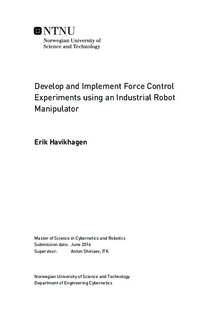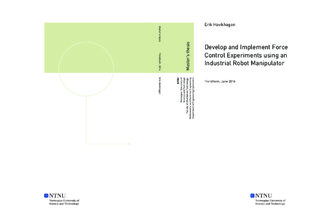| dc.description.abstract | In the last few decades there has been a large increase in industrial robots used in the machining industry. Industrial robots replaces manual labor in tedious tasks, and increases the level of precision of the process. There are however tasks that are still done by hand or by the use of CNC machines, where the use of industrial robots is limited. One case where the use of industrial robots is limited is in grinding, deburring and drilling of dense metals where a low level of error in the position is required. In these types of operations it is necessary to experiment with force control to discover behaviours that can be compensated, increasing the level of precision when using industrial robots.
The work done in this thesis consists mainly of three different types of experiments, where force control is the main aspect in all of them. All experiments follow a linear path along a metal bar, and forces between 1-30 N are applied on it using \textit{Machining FC} for the IRB 4600. At the end effector a wheel-rod tool is attached, which makes it possible to conduct experiments on the same metal bar without the concern for deformation. The different experiments look at how the behaviour changes when either the velocity or the path is changed. In addition a high precision camera system called the K-610 Series Optical CMM is used to compare deviation of the end effector position with the robot encoders. Different types of filters for use in post processing of the force signals were also investigated.
Conducting force control experiments gave several interesting results regarding the behaviour of the robot during the operation. It was discovered that the impact force increased by large degree when force applied increased. For the first experiment conducted it was discovered a large error offset for force measurements, which was reduced tremendously by experimenting with different approach and withdraw paths of the robot. Investigating the reduction of speed for the robot gave interesting results with how well the force control worked for small forces applied and the reduction of impact force. Oscillations could be seen for all the force measurements produced and reducing the velocity of the robot did little to reduce these oscillations. It was also experimented with a step based velocity method, which proved to be quite dissatisfied. From investigating three different types of filter it was concluded that the Butterworth filter gave the best response in reducing the noise of the measurements.
This thesis contributes with result and discussion of the different experiments done in regard to the use of force control. It also provides a thorough review of everything needed to produce additional force control experiments using this setup. In the next step it would be interesting to experiment with force control when drilling spindle is used, and to create controllers which compensate for undesired behaviour of the robot. | |

